|
SNAP Library 6.0, Developer Reference
2020-12-09 16:24:20
SNAP, a general purpose, high performance system for analysis and manipulation of large networks
|
|
SNAP Library 6.0, Developer Reference
2020-12-09 16:24:20
SNAP, a general purpose, high performance system for analysis and manipulation of large networks
|
#include <agmattr.h>
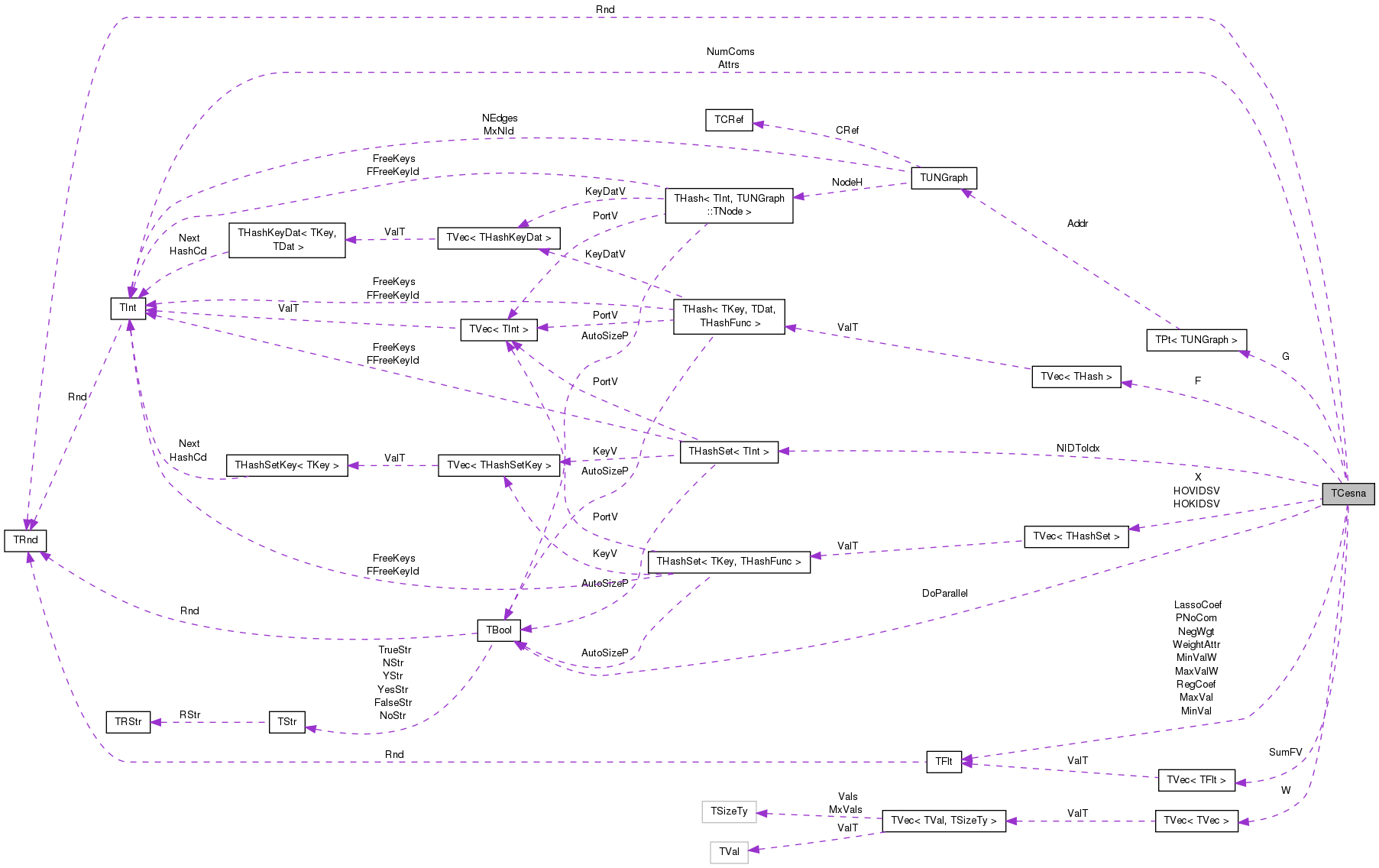
Public Member Functions | |
| TCesna () | |
| TCesna (const PUNGraph &GraphPt, const THash< TInt, TIntV > &NIDAttrH, const int &InitComs, const int RndSeed=0) | |
| void | Save (TSOut &SOut) |
| void | Load (TSIn &SIn, const int &RndSeed=0) |
| void | SetGraph (const PUNGraph &GraphPt, const THash< TInt, TIntV > &NIDAttrH) |
| void | SetRegCoef (const double _RegCoef) |
| double | GetRegCoef () |
| void | SetWeightAttr (const double _WeightAttr) |
| double | GetWeightAttr () |
| void | SetLassoCoef (const double _LassoCoef) |
| int | GetAttrs () |
| double | GetComFromNID (const int &NID, const int &CID) |
| double | GetLassoCoef () |
| void | InitW () |
| void | SetAttrHoldOut (const int NID, const int KID) |
| void | SetAttrHoldOutForOneNode (const int NID) |
| void | GetW (TVec< TFltV > &_W) |
| void | SetW (TVec< TFltV > &_W) |
| void | RandomInit (const int InitComs) |
| void | NeighborComInit (const int InitComs) |
| void | NeighborComInit (TFltIntPrV &NIdPhiV, const int InitComs) |
| int | GetNumComs () |
| void | SetCmtyVV (const TVec< TIntV > &CmtyVV) |
| double | Likelihood (const bool DoParallel=false) |
| double | LikelihoodForRow (const int UID) |
| double | LikelihoodForRow (const int UID, const TIntFltH &FU) |
| double | LikelihoodAttrKForRow (const int UID, const int K) |
| double | LikelihoodAttrKForRow (const int UID, const int K, const TIntFltH &FU) |
| double | LikelihoodAttrKForRow (const int UID, const int K, const TIntFltH &FU, const TFltV &WK) |
| double | LikelihoodForWK (const int K, const TFltV &WK) |
| double | LikelihoodForWK (const int K) |
| double | LikelihoodAttr () |
| double | LikelihoodGraph () |
| void | GenHoldOutAttr (const double HOFrac, TVec< TIntSet > &HOSetV) |
| void | SetHoldOut (const double HOFrac) |
| void | GradientForRow (const int UID, TIntFltH &GradU, const TIntSet &CIDSet) |
| void | GradientForWK (TFltV &GradV, const int K) |
| void | GetCmtyVV (TVec< TIntV > &CmtyVV) |
| void | GetCmtyVV (TVec< TIntV > &CmtyVV, TVec< TFltV > &Wck, const double Thres, const int MinSz=3) |
| extract community affiliation from F_uc Wck[c][k] = W_c for k-th attribute More... | |
| void | GetCmtyVV (TVec< TIntV > &CmtyVV, const double Thres, const int MinSz=3) |
| void | GetCmtyVV (TVec< TIntV > &CmtyVV, TVec< TFltV > &Wck) |
| void | GetCmtyVVUnSorted (TVec< TIntV > &CmtyVV) |
| void | GetCmtyVVUnSorted (TVec< TIntV > &CmtyVV, const double Thres, const int MinSz=3) |
| int | FindComs (TIntV &ComsV, const bool UseBIC=false, const double HOFrac=0.2, const int NumThreads=20, const TStr PlotLFNm=TStr(), const double StepAlpha=0.3, const double StepBeta=0.1) |
| int | FindComs (const int NumThreads, const int MaxComs, const int MinComs, const int DivComs, const TStr OutFNm, const bool UseBIC=false, const double HOFrac=0.1, const double StepAlpha=0.3, const double StepBeta=0.3) |
| estimate number of communities using cross validation More... | |
| void | DisplayAttrs (const int TopK, const TStrHash< TInt > &NodeNameH) |
| double | LikelihoodHoldOut () |
| double | GetStepSizeByLineSearch (const int UID, const TIntFltH &DeltaV, const TIntFltH &GradV, const double &Alpha, const double &Beta, const int MaxIter=10) |
| double | GetStepSizeByLineSearchForWK (const int K, const TFltV &DeltaV, const TFltV &GradV, const double &Alpha, const double &Beta, const int MaxIter=10) |
| int | GetPositiveW () |
| int | MLEGradAscent (const double &Thres, const int &MaxIter, const TStr PlotNm, const double StepAlpha=0.3, const double StepBeta=0.1) |
| int | MLEGradAscentParallel (const double &Thres, const int &MaxIter, const int ChunkNum, const int ChunkSize, const TStr PlotNm, const double StepAlpha=0.3, const double StepBeta=0.1) |
| int | MLEGradAscentParallel (const double &Thres, const int &MaxIter, const int ChunkNum, const TStr PlotNm=TStr(), const double StepAlpha=0.3, const double StepBeta=0.1) |
| double | GetCom (const int &NID, const int &CID) |
| double | GetAttr (const int &NID, const int &K) |
| void | AddCom (const int &NID, const int &CID, const double &Val) |
| void | DelCom (const int &NID, const int &CID) |
| double | DotProduct (const TIntFltH &UV, const TIntFltH &VV) |
| double | DotProduct (const int &UID, const int &VID) |
| double | Prediction (const TIntFltH &FU, const TIntFltH &FV) |
| double | PredictAttrK (const TIntFltH &FU, const TFltV &WK) |
| double | PredictAttrK (const TIntFltH &FU, const int K) |
| double | PredictAttrK (const int UID, const int K) |
| double | GetW (const int CID, const int K) |
| double | Prediction (const int &UID, const int &VID) |
| double | Sum (const TIntFltH &UV) |
| double | Norm2 (const TIntFltH &UV) |
| double | Sigmoid (const double X) |
Public Attributes | |
| TFlt | MinVal |
| TFlt | MaxVal |
| TFlt | MinValW |
| TFlt | MaxValW |
| TFlt | NegWgt |
| TFlt | LassoCoef |
| TFlt | WeightAttr |
| TFlt | PNoCom |
| TBool | DoParallel |
Private Attributes | |
| PUNGraph | G |
| TVec< TIntSet > | X |
| TVec< TIntFltH > | F |
| TVec< TFltV > | W |
| TInt | Attrs |
| TRnd | Rnd |
| TIntSet | NIDToIdx |
| TFlt | RegCoef |
| TFltV | SumFV |
| TInt | NumComs |
| TVec< TIntSet > | HOVIDSV |
| TVec< TIntSet > | HOKIDSV |
|
inline |
Definition at line 271 of file agmattr.h.
References TUNGraph::New().

|
inline |
Definition at line 272 of file agmattr.h.
References NeighborComInit(), and SetGraph().
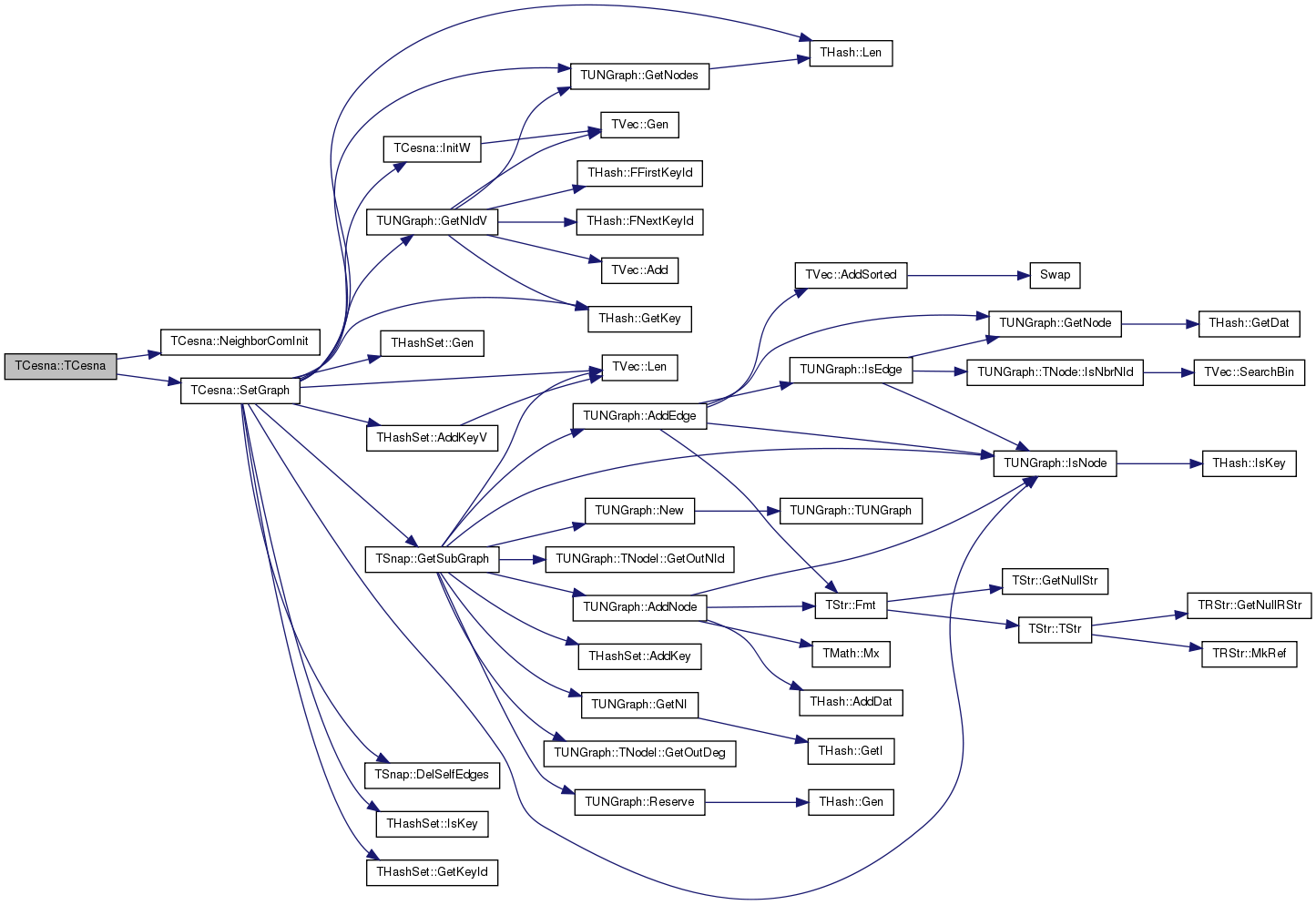
|
inline |
Definition at line 541 of file agmattr.h.
References TVec< TVal, TSizeTy >::GetDat().
Referenced by MLEGradAscent(), NeighborComInit(), RandomInit(), and SetCmtyVV().


|
inline |
Definition at line 549 of file agmattr.h.
References TVec< TVal, TSizeTy >::GetDat().
Referenced by MLEGradAscent().


Definition at line 470 of file agmattr.h.
References TStrHash< TDat, TStringPool, THashFunc >::GetKey(), TVec< TVal, TSizeTy >::Len(), and TStrHash< TDat, TStringPool, THashFunc >::Len().
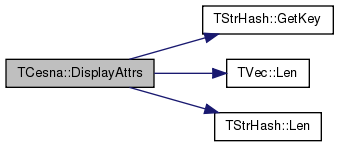
Definition at line 564 of file agmattr.h.
References THash< TKey, TDat, THashFunc >::BegI(), THash< TKey, TDat, THashFunc >::EndI(), THash< TKey, TDat, THashFunc >::GetDat(), THash< TKey, TDat, THashFunc >::IsKey(), and THash< TKey, TDat, THashFunc >::Len().
Referenced by DotProduct(), GetStepSizeByLineSearch(), LikelihoodForRow(), and Prediction().
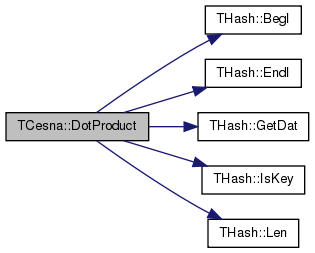

|
inline |
Definition at line 581 of file agmattr.h.
References DotProduct().
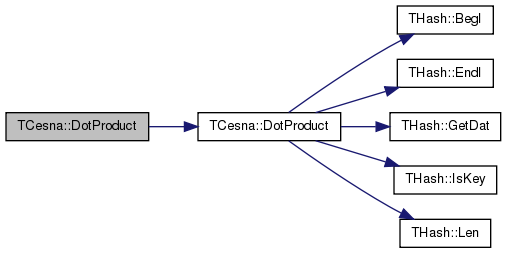
| int TCesna::FindComs | ( | TIntV & | ComsV, |
| const bool | UseBIC = false, |
||
| const double | HOFrac = 0.2, |
||
| const int | NumThreads = 20, |
||
| const TStr | PlotLFNm = TStr(), |
||
| const double | StepAlpha = 0.3, |
||
| const double | StepBeta = 0.1 |
||
| ) |
Definition at line 361 of file agmattr.cpp.
References TVec< TVal, TSizeTy >::Add(), Attrs, TStr::Empty(), G, GenHoldOutAttr(), TCesnaUtil::GenHoldOutPairs(), TUNGraph::GetNodes(), HOKIDSV, HOVIDSV, TVec< TVal, TSizeTy >::Last(), TVec< TVal, TSizeTy >::Len(), Likelihood(), LikelihoodAttr(), LikelihoodHoldOut(), MLEGradAscent(), MLEGradAscentParallel(), TFlt::Mn, NeighborComInit(), TGnuPlot::PlotValV(), RandomInit(), Rnd, and WeightAttr.
Referenced by FindComs().
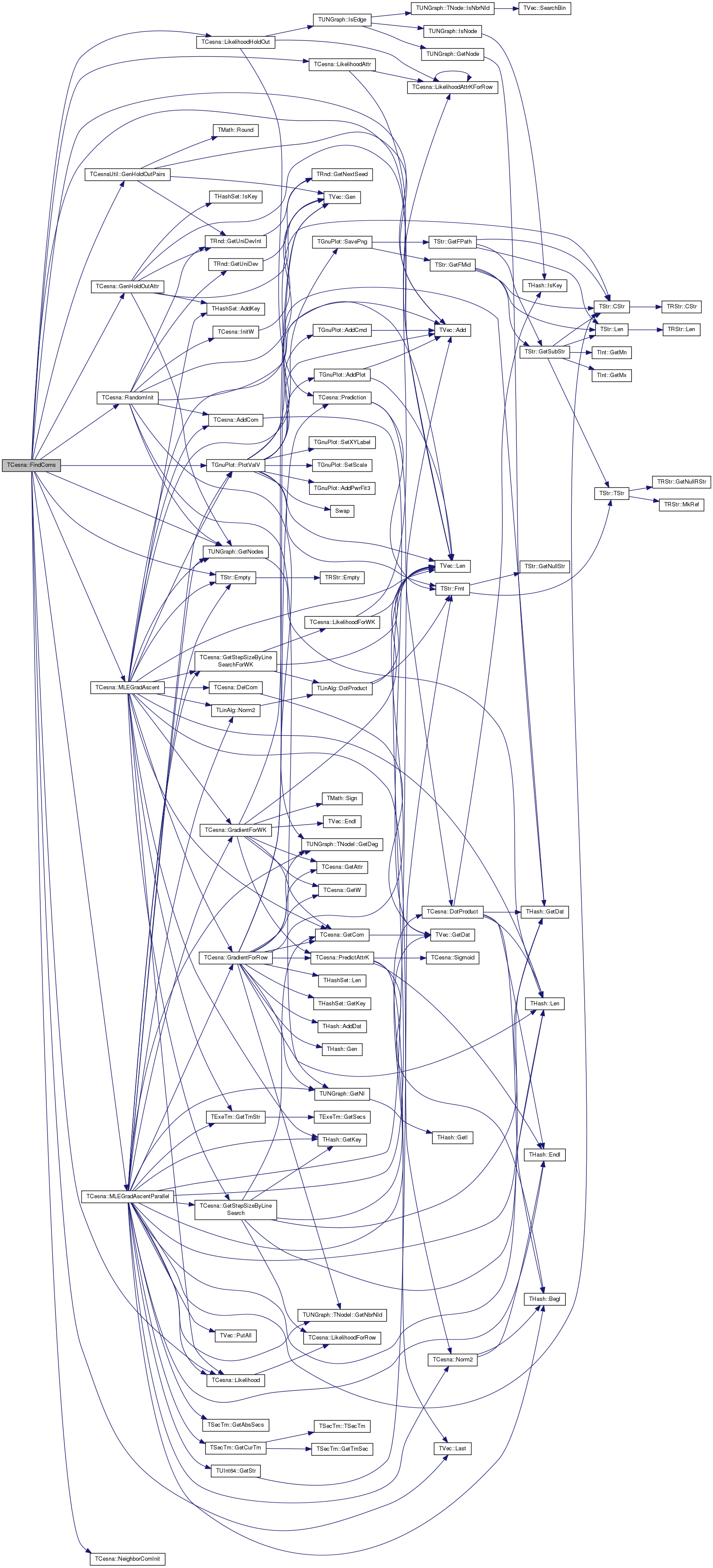

| int TCesna::FindComs | ( | const int | NumThreads, |
| const int | MaxComs, | ||
| const int | MinComs, | ||
| const int | DivComs, | ||
| const TStr | OutFNm, | ||
| const bool | UseBIC = false, |
||
| const double | HOFrac = 0.1, |
||
| const double | StepAlpha = 0.3, |
||
| const double | StepBeta = 0.3 |
||
| ) |
estimate number of communities using cross validation
Definition at line 348 of file agmattr.cpp.
References TVec< TVal, TSizeTy >::Add(), FindComs(), TVec< TVal, TSizeTy >::Last(), TVec< TVal, TSizeTy >::Len(), TMath::Log(), and TInt::Val.
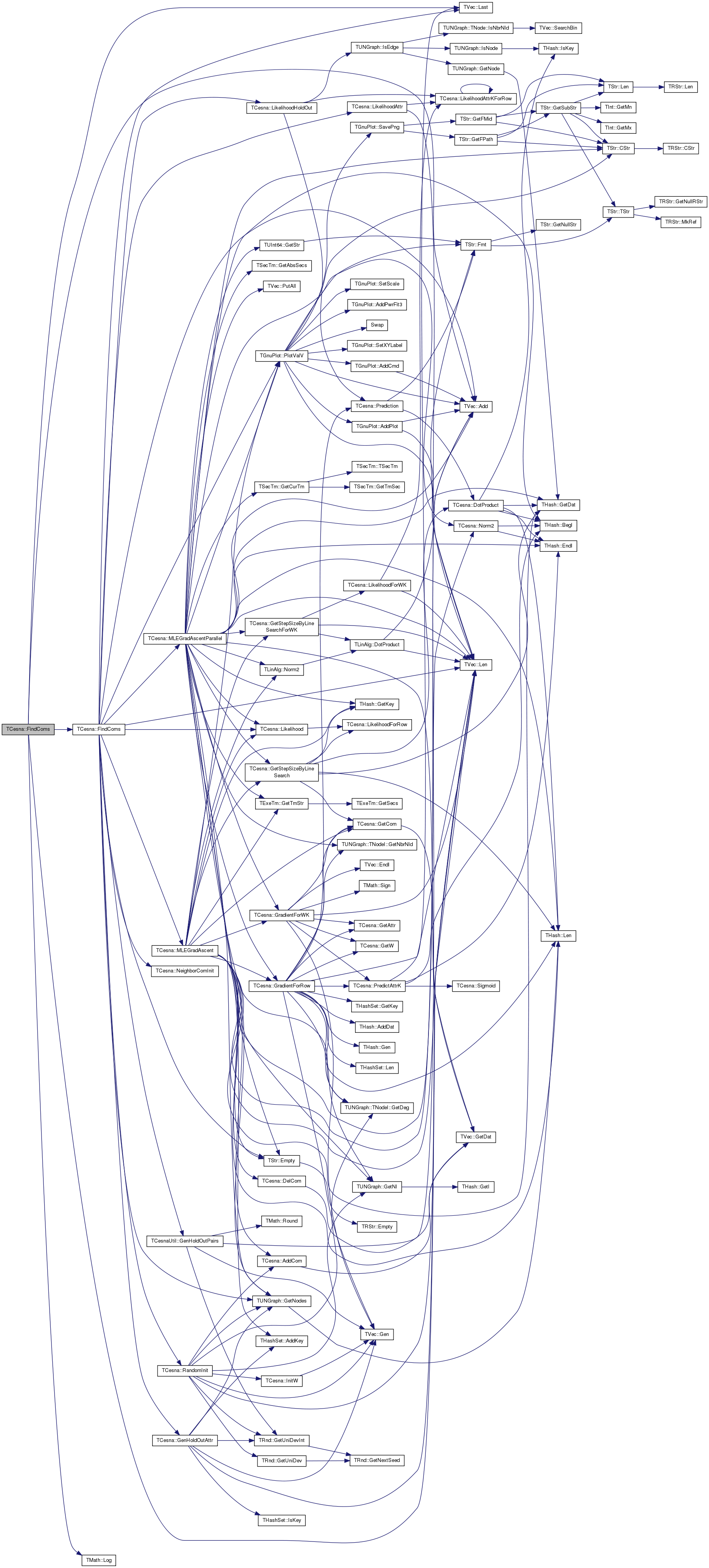
Definition at line 397 of file agmattr.h.
References THashSet< TKey, THashFunc >::AddKey(), Attrs, TVec< TVal, TSizeTy >::Gen(), TUNGraph::GetNodes(), TRnd::GetUniDevInt(), THashSet< TKey, THashFunc >::IsKey(), and TVec< TVal, TSizeTy >::Len().
Referenced by FindComs(), and SetHoldOut().
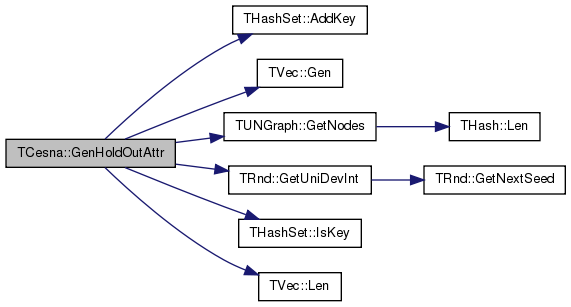

|
inline |
Definition at line 534 of file agmattr.h.
Referenced by GradientForRow(), GradientForWK(), and LikelihoodAttrKForRow().

Definition at line 289 of file agmattr.cpp.
References G, TUNGraph::GetEdges(), and TUNGraph::GetNodes().
Referenced by GetCmtyVV().


| void TCesna::GetCmtyVV | ( | TVec< TIntV > & | CmtyVV, |
| TVec< TFltV > & | Wck, | ||
| const double | Thres, | ||
| const int | MinSz = 3 |
||
| ) |
extract community affiliation from F_uc Wck[c][k] = W_c for k-th attribute
Definition at line 296 of file agmattr.cpp.
References TVec< TVal, TSizeTy >::Add(), THash< TKey, TDat, THashFunc >::AddDat(), Attrs, F, TVec< TVal, TSizeTy >::Gen(), GetCom(), THash< TKey, TDat, THashFunc >::GetDat(), THash< TKey, TDat, THashFunc >::GetKey(), THashSet< TKey, THashFunc >::GetKeyV(), GetW(), IAssert, TVec< TVal, TSizeTy >::Len(), NIDToIdx, NumComs, THash< TKey, TDat, THashFunc >::SortByDat(), and SumFV.
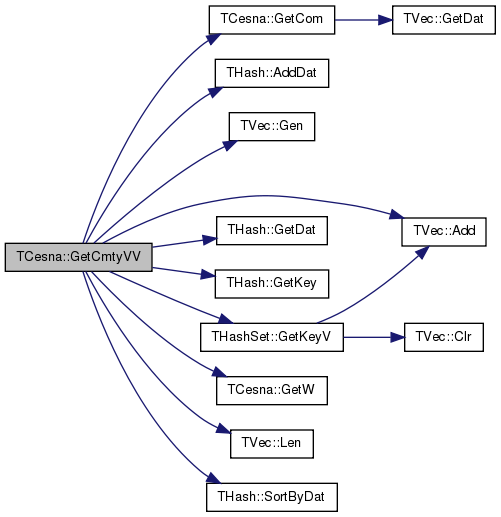
Definition at line 438 of file agmattr.h.
References GetCmtyVV().

Definition at line 442 of file agmattr.h.
References GetCmtyVV(), TUNGraph::GetEdges(), and TUNGraph::GetNodes().

Definition at line 329 of file agmattr.cpp.
References G, TUNGraph::GetEdges(), and TUNGraph::GetNodes().

Definition at line 333 of file agmattr.cpp.
References TVec< TVal, TSizeTy >::Add(), G, TVec< TVal, TSizeTy >::Gen(), GetCom(), TUNGraph::GetNodes(), TVec< TVal, TSizeTy >::Len(), NIDToIdx, and NumComs.
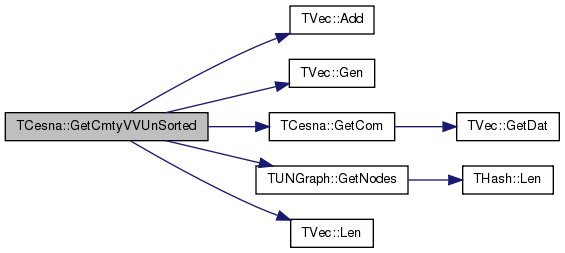
|
inline |
Definition at line 527 of file agmattr.h.
References TVec< TVal, TSizeTy >::GetDat().
Referenced by GetCmtyVV(), GetCmtyVVUnSorted(), GetStepSizeByLineSearch(), GradientForRow(), GradientForWK(), LikelihoodForRow(), and MLEGradAscent().

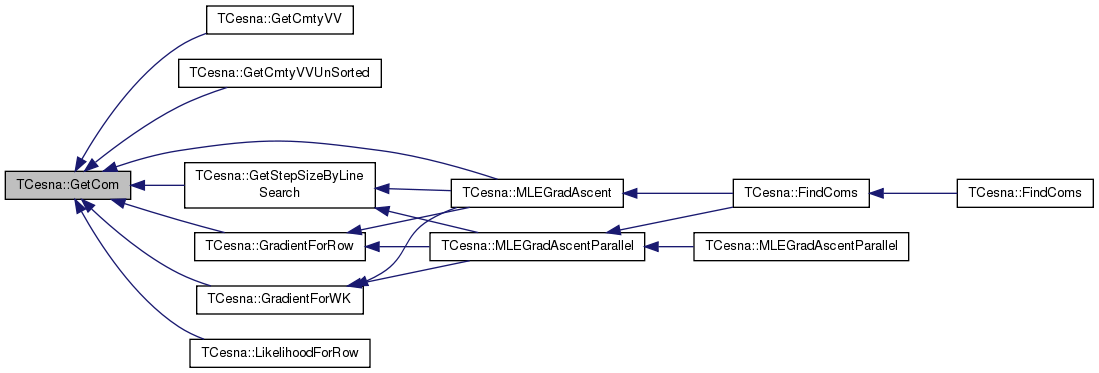
|
inline |
Definition at line 322 of file agmattr.h.
References TVec< TVal, TSizeTy >::GetDat(), and THashSet< TKey, THashFunc >::GetKeyId().

|
inline |
|
inline |
| double TCesna::GetStepSizeByLineSearch | ( | const int | UID, |
| const TIntFltH & | DeltaV, | ||
| const TIntFltH & | GradV, | ||
| const double & | Alpha, | ||
| const double & | Beta, | ||
| const int | MaxIter = 10 |
||
| ) |
Definition at line 480 of file agmattr.cpp.
References DotProduct(), GetCom(), THash< TKey, TDat, THashFunc >::GetDat(), THash< TKey, TDat, THashFunc >::GetKey(), THash< TKey, TDat, THashFunc >::Len(), LikelihoodForRow(), MaxVal, and MinVal.
Referenced by MLEGradAscent(), and MLEGradAscentParallel().
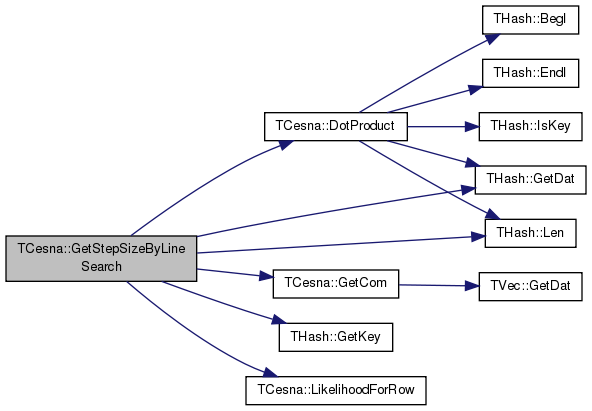

|
inline |
Definition at line 486 of file agmattr.h.
References TLinAlg::DotProduct(), IAssert, TVec< TVal, TSizeTy >::Len(), LikelihoodForWK(), MaxValW, and MinValW.
Referenced by MLEGradAscent(), and MLEGradAscentParallel().


Definition at line 346 of file agmattr.h.
References W.
Referenced by GetCmtyVV(), GetPositiveW(), GradientForRow(), and GradientForWK().

|
inline |
|
inline |
Definition at line 213 of file agmattr.cpp.
References THash< TKey, TDat, THashFunc >::AddDat(), Attrs, F, G, THash< TKey, TDat, THashFunc >::Gen(), TVec< TVal, TSizeTy >::Gen(), GetAttr(), GetCom(), TUNGraph::TNodeI::GetDeg(), THashSet< TKey, THashFunc >::GetKey(), TUNGraph::TNodeI::GetNbrNId(), TUNGraph::GetNI(), GetW(), HOKIDSV, HOVIDSV, IAssert, THash< TKey, TDat, THashFunc >::Len(), TVec< TVal, TSizeTy >::Len(), THashSet< TKey, THashFunc >::Len(), NegWgt, PredictAttrK(), Prediction(), RegCoef, SumFV, W, and WeightAttr.
Referenced by MLEGradAscent(), and MLEGradAscentParallel().
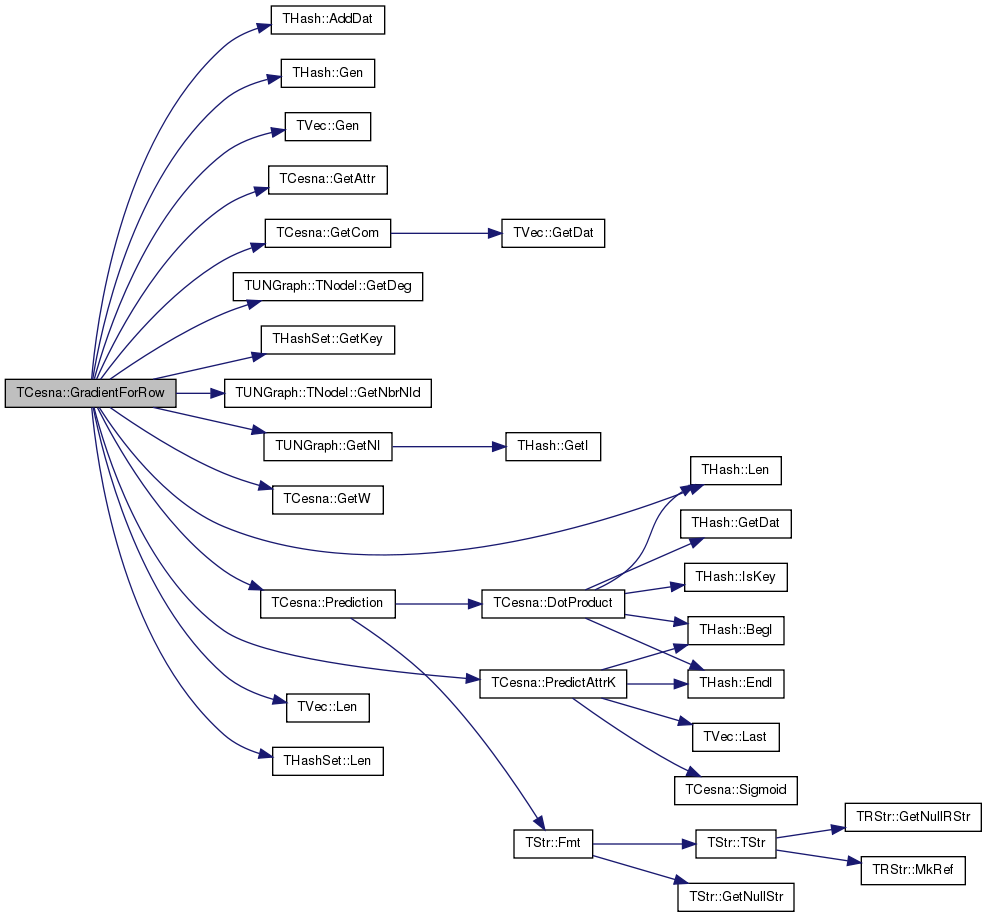

|
inline |
Definition at line 421 of file agmattr.h.
References TVec< TVal, TSizeTy >::EndI(), TVec< TVal, TSizeTy >::Gen(), GetAttr(), GetCom(), GetW(), TVec< TVal, TSizeTy >::Len(), NumComs, PredictAttrK(), and TMath::Sign().
Referenced by MLEGradAscent(), and MLEGradAscentParallel().


|
inline |
Definition at line 331 of file agmattr.h.
References Attrs, and TVec< TVal, TSizeTy >::Gen().
Referenced by NeighborComInit(), RandomInit(), SetCmtyVV(), and SetGraph().


| double TCesna::Likelihood | ( | const bool | DoParallel = false | ) |
Definition at line 137 of file agmattr.cpp.
References F, and LikelihoodForRow().
Referenced by FindComs(), LikelihoodGraph(), MLEGradAscent(), and MLEGradAscentParallel().


|
inline |
Definition at line 371 of file agmattr.h.
References Attrs, TVec< TVal, TSizeTy >::Len(), and LikelihoodAttrKForRow().
Referenced by FindComs(), and LikelihoodGraph().


|
inline |
Definition at line 356 of file agmattr.h.
References LikelihoodAttrKForRow().
Referenced by LikelihoodAttr(), LikelihoodAttrKForRow(), LikelihoodForRow(), LikelihoodForWK(), and LikelihoodHoldOut().


|
inline |
Definition at line 357 of file agmattr.h.
References LikelihoodAttrKForRow().
Referenced by LikelihoodAttrKForRow().


| double TCesna::LikelihoodAttrKForRow | ( | const int | UID, |
| const int | K, | ||
| const TIntFltH & | FU, | ||
| const TFltV & | WK | ||
| ) |
Definition at line 202 of file agmattr.cpp.
References GetAttr(), and PredictAttrK().
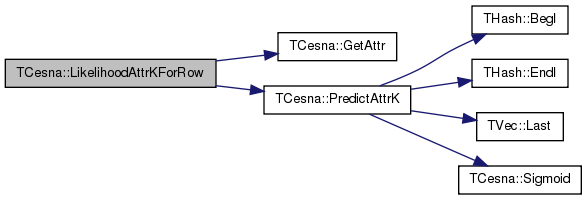
| double TCesna::LikelihoodForRow | ( | const int | UID | ) |
Definition at line 157 of file agmattr.cpp.
References F.
Referenced by GetStepSizeByLineSearch(), and Likelihood().

| double TCesna::LikelihoodForRow | ( | const int | UID, |
| const TIntFltH & | FU | ||
| ) |
Definition at line 161 of file agmattr.cpp.
References Attrs, THash< TKey, TDat, THashFunc >::BegI(), DotProduct(), THash< TKey, TDat, THashFunc >::EndI(), F, G, TVec< TVal, TSizeTy >::Gen(), GetCom(), TUNGraph::TNodeI::GetDeg(), TUNGraph::TNodeI::GetNbrNId(), TUNGraph::GetNI(), HOKIDSV, HOVIDSV, TVec< TVal, TSizeTy >::Len(), LikelihoodAttrKForRow(), NegWgt, Norm2(), Prediction(), RegCoef, Sum(), SumFV, and WeightAttr.
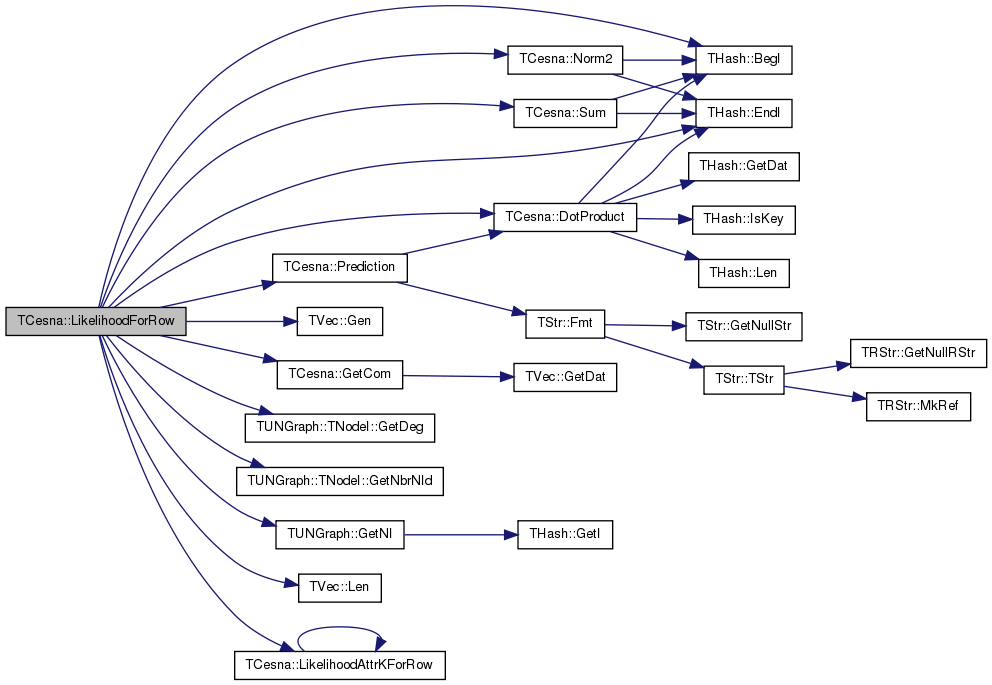
|
inline |
Definition at line 359 of file agmattr.h.
References TVec< TVal, TSizeTy >::Len(), and LikelihoodAttrKForRow().
Referenced by GetStepSizeByLineSearchForWK().


|
inline |
Definition at line 370 of file agmattr.h.
References LikelihoodForWK().
Referenced by LikelihoodForWK().


|
inline |
Definition at line 381 of file agmattr.h.
References TVec< TVal, TSizeTy >::Len(), Likelihood(), LikelihoodAttr(), Norm2(), and Sum().
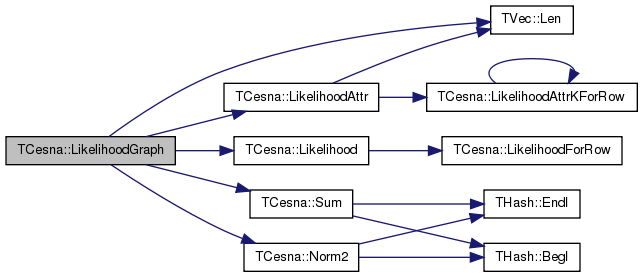
| double TCesna::LikelihoodHoldOut | ( | ) |
Definition at line 452 of file agmattr.cpp.
References Attrs, G, HOKIDSV, HOVIDSV, IAssert, TUNGraph::IsEdge(), LikelihoodAttrKForRow(), NegWgt, Prediction(), and WeightAttr.
Referenced by FindComs().
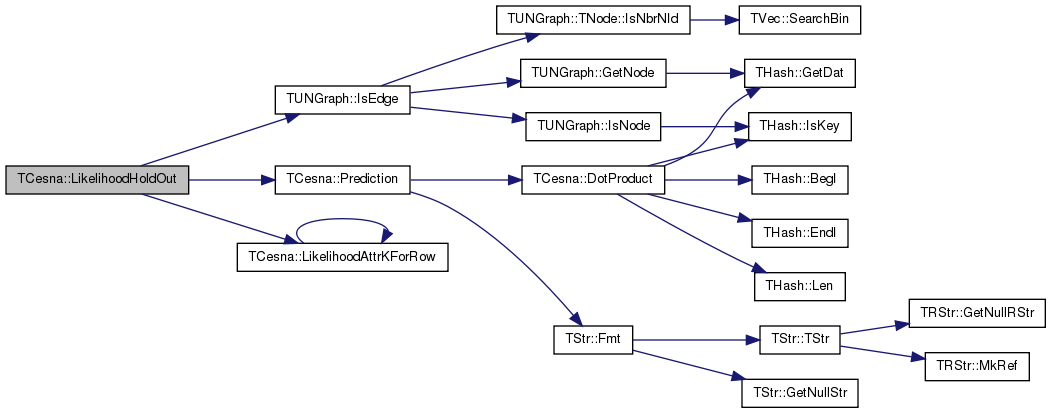

|
inline |
Definition at line 294 of file agmattr.h.
References TUNGraph::Load(), TVec< TVal, TSizeTy >::Load(), THashSet< TKey, THashFunc >::Load(), TInt::Load(), and TFlt::Load().
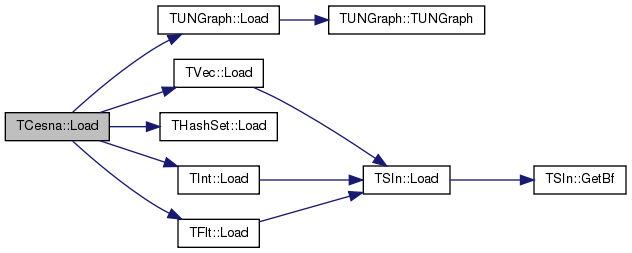
| int TCesna::MLEGradAscent | ( | const double & | Thres, |
| const int & | MaxIter, | ||
| const TStr | PlotNm, | ||
| const double | StepAlpha = 0.3, |
||
| const double | StepBeta = 0.1 |
||
| ) |
Definition at line 505 of file agmattr.cpp.
References TVec< TVal, TSizeTy >::Add(), AddCom(), THashSet< TKey, THashFunc >::AddKey(), Attrs, DelCom(), TStr::Empty(), F, G, GetCom(), THash< TKey, TDat, THashFunc >::GetDat(), THash< TKey, TDat, THashFunc >::GetKey(), TUNGraph::GetNodes(), GetStepSizeByLineSearch(), GetStepSizeByLineSearchForWK(), TExeTm::GetTmStr(), GradientForRow(), GradientForWK(), THash< TKey, TDat, THashFunc >::Len(), TVec< TVal, TSizeTy >::Len(), Likelihood(), MaxValW, MinValW, TFlt::Mn, TLinAlg::Norm2(), Norm2(), NumComs, TGnuPlot::PlotValV(), Rnd, and W.
Referenced by FindComs().
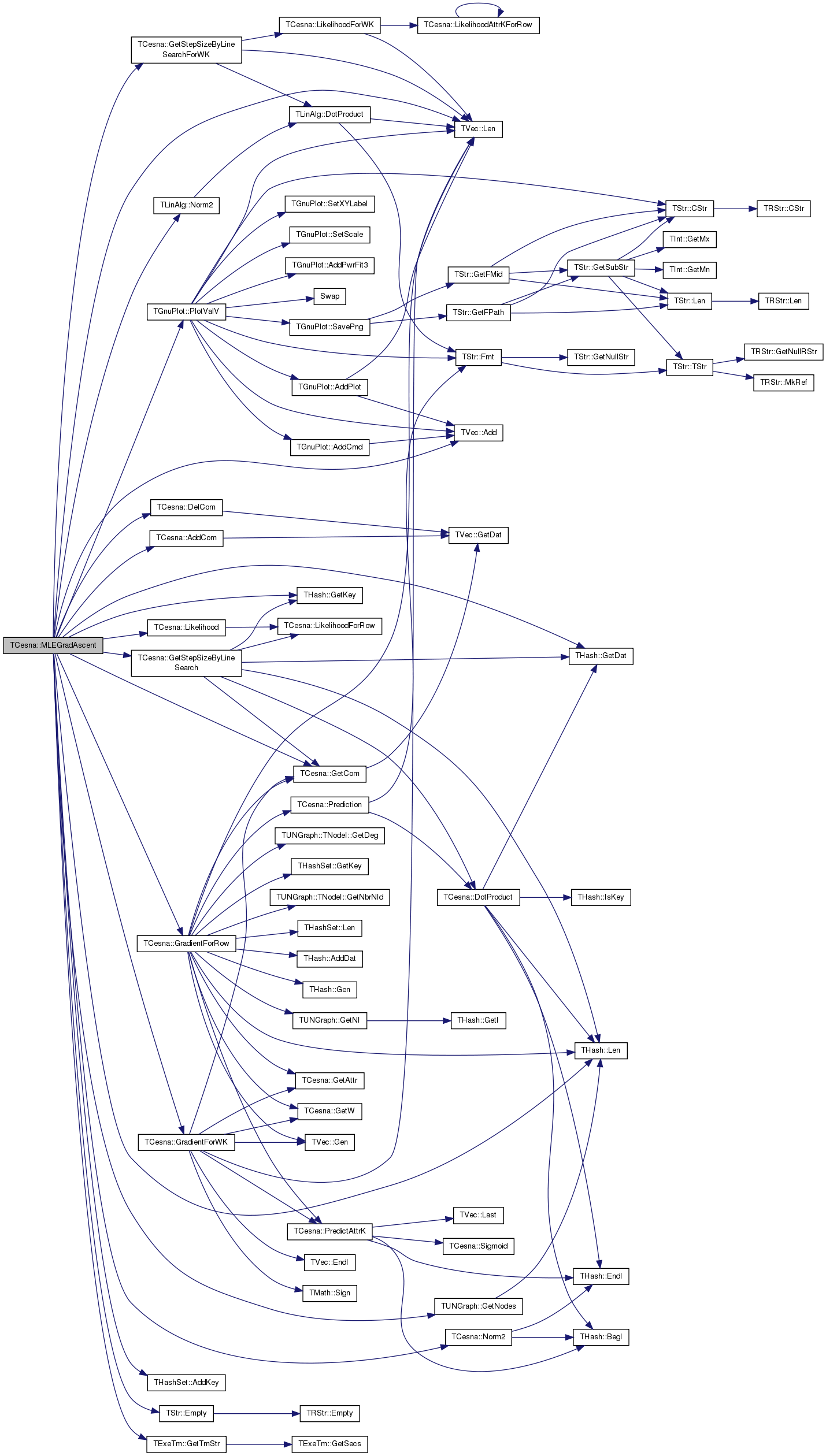

| int TCesna::MLEGradAscentParallel | ( | const double & | Thres, |
| const int & | MaxIter, | ||
| const int | ChunkNum, | ||
| const int | ChunkSize, | ||
| const TStr | PlotNm, | ||
| const double | StepAlpha = 0.3, |
||
| const double | StepBeta = 0.1 |
||
| ) |
Definition at line 594 of file agmattr.cpp.
References TVec< TVal, TSizeTy >::Add(), Attrs, THash< TKey, TDat, THashFunc >::BegI(), TStr::CStr(), TStr::Empty(), THashKeyDatI< TKey, TDat >::EndI, THash< TKey, TDat, THashFunc >::EndI(), F, G, TSecTm::GetAbsSecs(), TSecTm::GetCurTm(), THash< TKey, TDat, THashFunc >::GetDat(), TVec< TVal, TSizeTy >::GetDat(), TUNGraph::TNodeI::GetDeg(), THash< TKey, TDat, THashFunc >::GetKey(), TUNGraph::TNodeI::GetNbrNId(), TUNGraph::GetNI(), TUNGraph::GetNodes(), GetStepSizeByLineSearch(), GetStepSizeByLineSearchForWK(), TUInt64::GetStr(), TExeTm::GetTmStr(), GradientForRow(), GradientForWK(), HOVIDSV, IAssert, THash< TKey, TDat, THashFunc >::Len(), TVec< TVal, TSizeTy >::Len(), Likelihood(), MaxValW, MinValW, TFlt::Mn, TLinAlg::Norm2(), Norm2(), NumComs, TGnuPlot::PlotValV(), TVec< TVal, TSizeTy >::PutAll(), Rnd, SumFV, and W.
Referenced by FindComs(), and MLEGradAscentParallel().
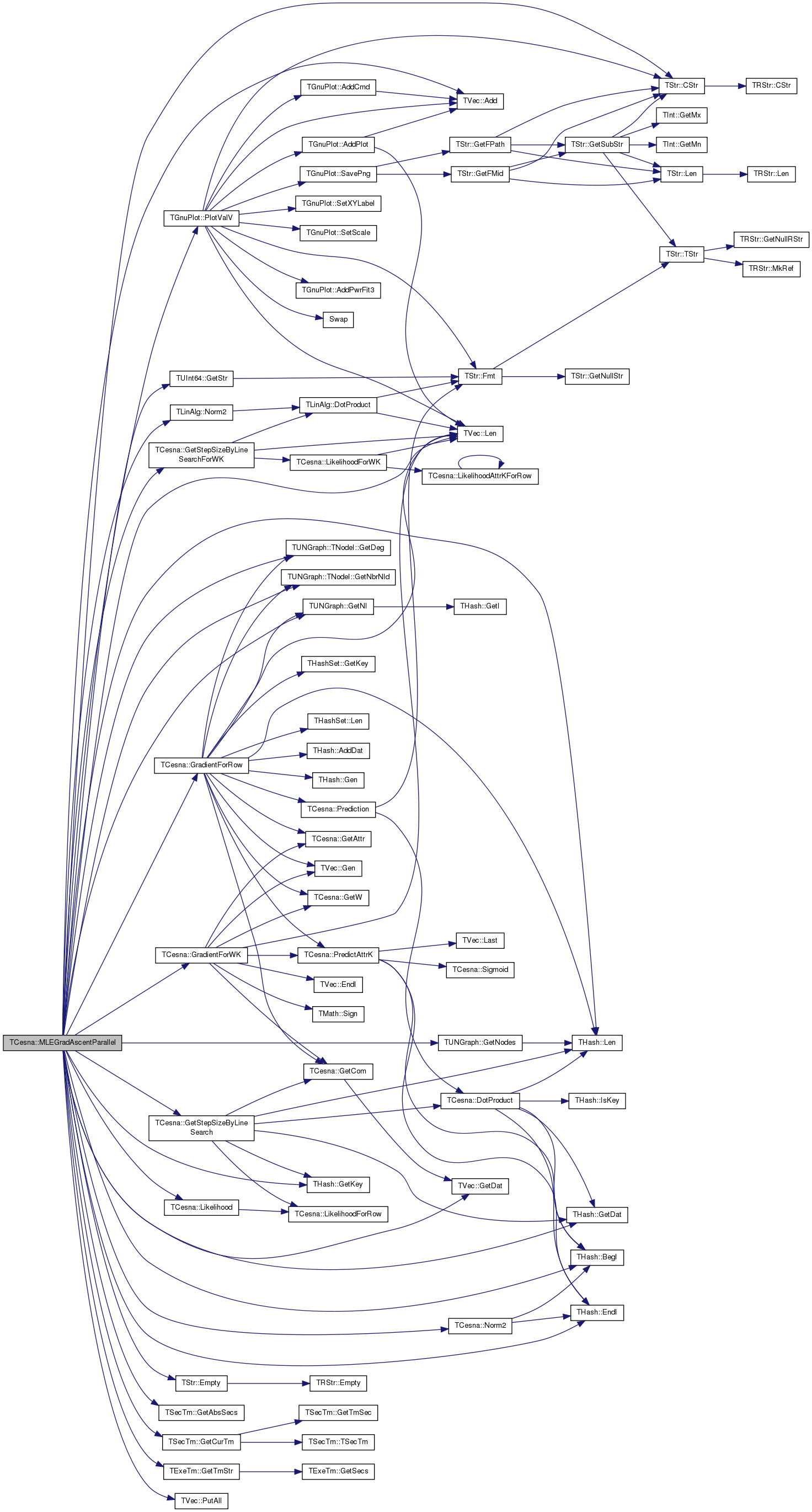

|
inline |
Definition at line 521 of file agmattr.h.
References TUNGraph::GetNodes(), and MLEGradAscentParallel().
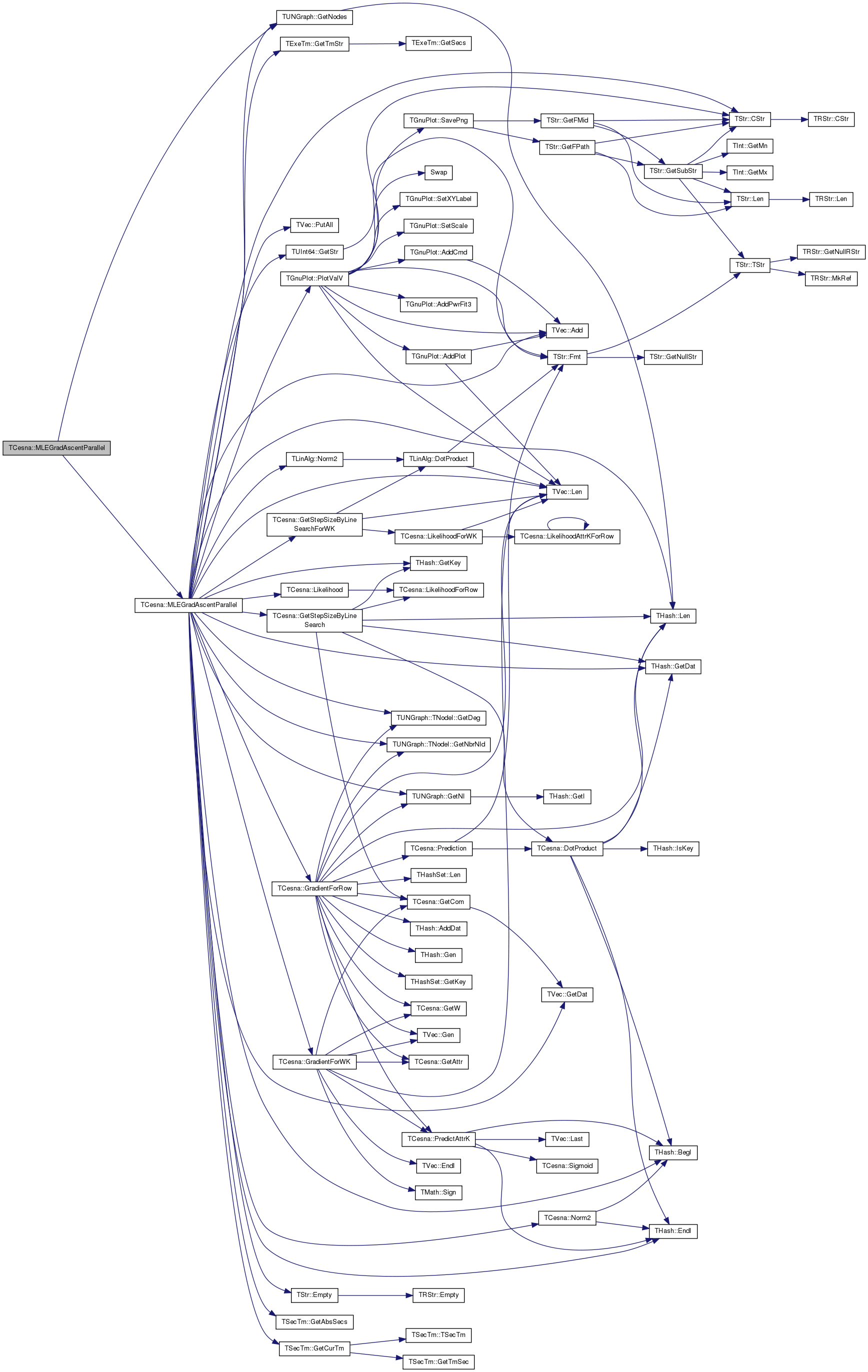
| void TCesna::NeighborComInit | ( | const int | InitComs | ) |
Definition at line 32 of file agmattr.cpp.
Referenced by FindComs(), and TCesna().

| void TCesna::NeighborComInit | ( | TFltIntPrV & | NIdPhiV, |
| const int | InitComs | ||
| ) |
Definition at line 39 of file agmattr.cpp.
References AddCom(), F, G, TVec< TVal, TSizeTy >::Gen(), TUNGraph::TNodeI::GetDeg(), TUNGraph::TNodeI::GetNbrNId(), TUNGraph::GetNI(), TUNGraph::GetNodes(), TRnd::GetUniDev(), TRnd::GetUniDevInt(), InitW(), TVec< TVal, TSizeTy >::Len(), NumComs, Rnd, TVec< TVal, TSizeTy >::Sort(), and SumFV.
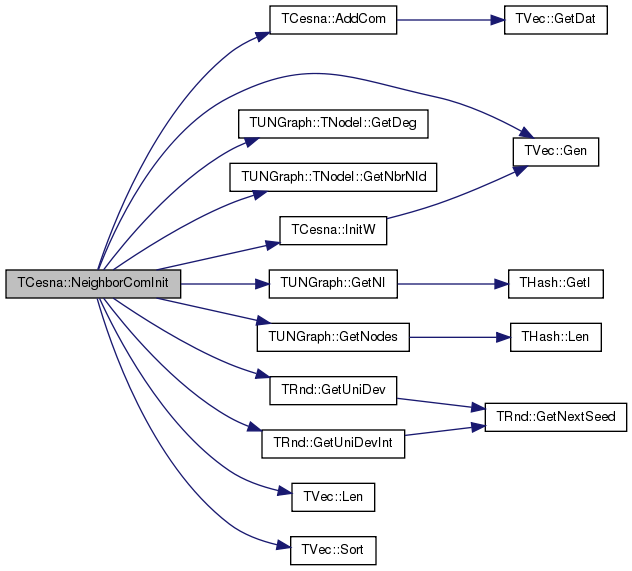
|
inline |
Definition at line 616 of file agmattr.h.
References THash< TKey, TDat, THashFunc >::BegI(), and THash< TKey, TDat, THashFunc >::EndI().
Referenced by LikelihoodForRow(), LikelihoodGraph(), MLEGradAscent(), and MLEGradAscentParallel().


Definition at line 589 of file agmattr.h.
References THash< TKey, TDat, THashFunc >::BegI(), THash< TKey, TDat, THashFunc >::EndI(), TVec< TVal, TSizeTy >::Last(), and Sigmoid().
Referenced by GradientForRow(), GradientForWK(), LikelihoodAttrKForRow(), and PredictAttrK().
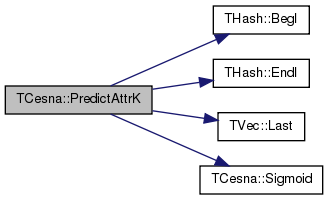

|
inline |
Definition at line 597 of file agmattr.h.
References PredictAttrK().
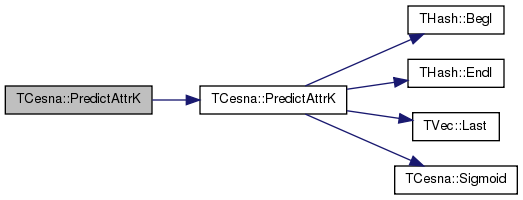
|
inline |
Definition at line 600 of file agmattr.h.
References PredictAttrK().
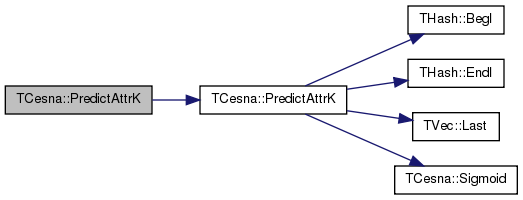
Definition at line 584 of file agmattr.h.
References DotProduct(), TStr::Fmt(), and IAssertR.
Referenced by GradientForRow(), LikelihoodForRow(), LikelihoodHoldOut(), and Prediction().
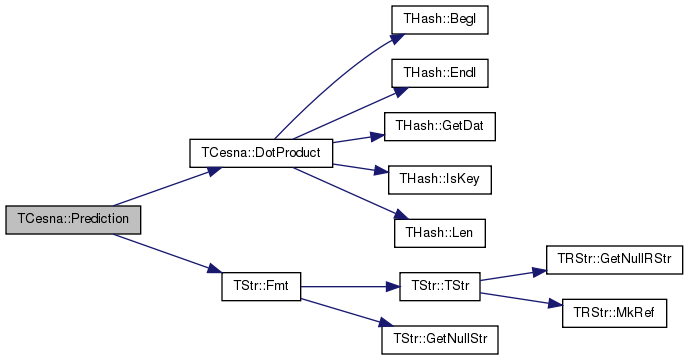

|
inline |
Definition at line 606 of file agmattr.h.
References Prediction().
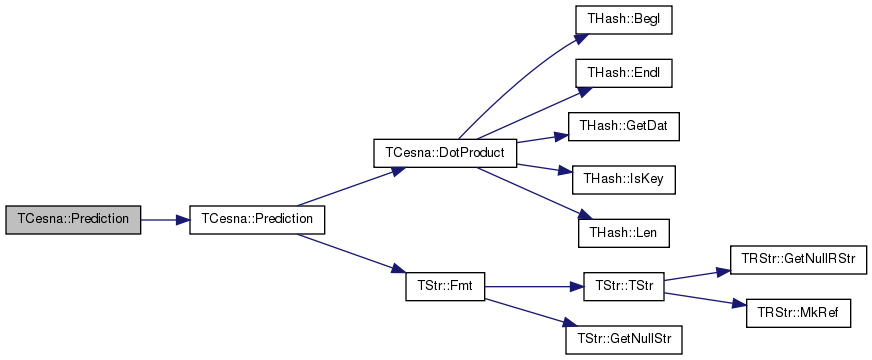
| void TCesna::RandomInit | ( | const int | InitComs | ) |
Definition at line 9 of file agmattr.cpp.
References AddCom(), F, G, TVec< TVal, TSizeTy >::Gen(), TUNGraph::TNodeI::GetDeg(), TUNGraph::GetNI(), TUNGraph::GetNodes(), TRnd::GetUniDev(), TRnd::GetUniDevInt(), InitW(), TVec< TVal, TSizeTy >::Len(), NumComs, Rnd, and SumFV.
Referenced by FindComs().
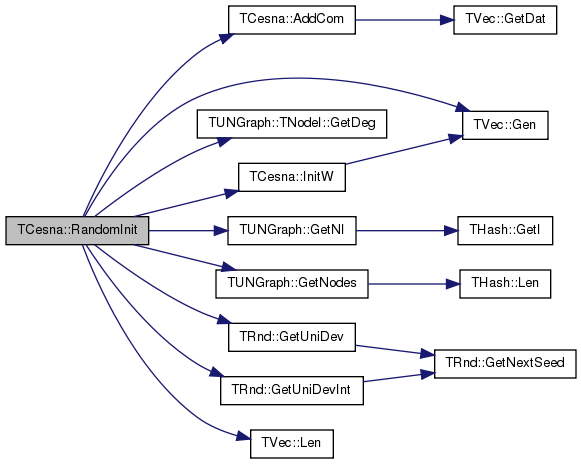

|
inline |
Definition at line 274 of file agmattr.h.
References TUNGraph::Save(), TVec< TVal, TSizeTy >::Save(), THashSet< TKey, THashFunc >::Save(), TInt::Save(), and TFlt::Save().
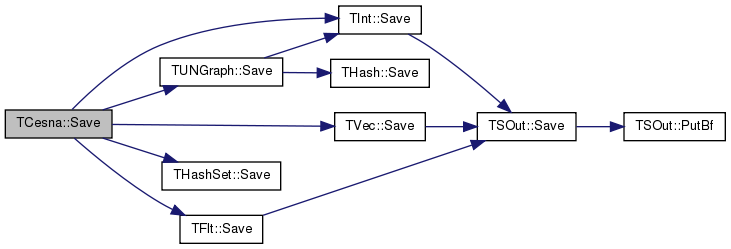
|
inline |
Definition at line 337 of file agmattr.h.
References THashSet< TKey, THashFunc >::GetKeyId().
Referenced by SetAttrHoldOutForOneNode().


|
inline |
Definition at line 341 of file agmattr.h.
References Attrs, and SetAttrHoldOut().

Definition at line 85 of file agmattr.cpp.
References AddCom(), F, G, TVec< TVal, TSizeTy >::Gen(), THashSet< TKey, THashFunc >::GetKeyId(), TUNGraph::GetNodes(), InitW(), THashSet< TKey, THashFunc >::IsKey(), TVec< TVal, TSizeTy >::Len(), NIDToIdx, NumComs, and SumFV.
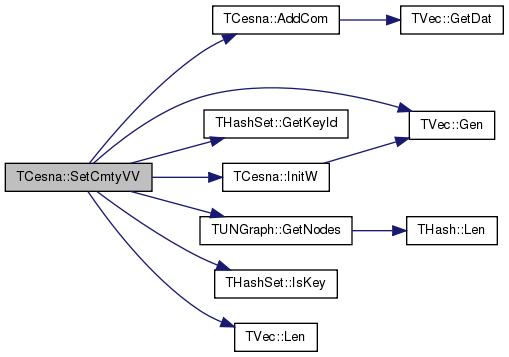
Definition at line 99 of file agmattr.cpp.
References THashSet< TKey, THashFunc >::AddKeyV(), Attrs, TSnap::DelSelfEdges(), DoParallel, G, THashSet< TKey, THashFunc >::Gen(), THash< TKey, TDat, THashFunc >::GetKey(), THashSet< TKey, THashFunc >::GetKeyId(), TUNGraph::GetNIdV(), TUNGraph::GetNodes(), TSnap::GetSubGraph(), HOKIDSV, HOVIDSV, IAssert, InitW(), THashSet< TKey, THashFunc >::IsKey(), TUNGraph::IsNode(), THash< TKey, TDat, THashFunc >::Len(), TVec< TVal, TSizeTy >::Len(), TFlt::Mx, NegWgt, NIDToIdx, PNoCom, and X.
Referenced by TCesna().
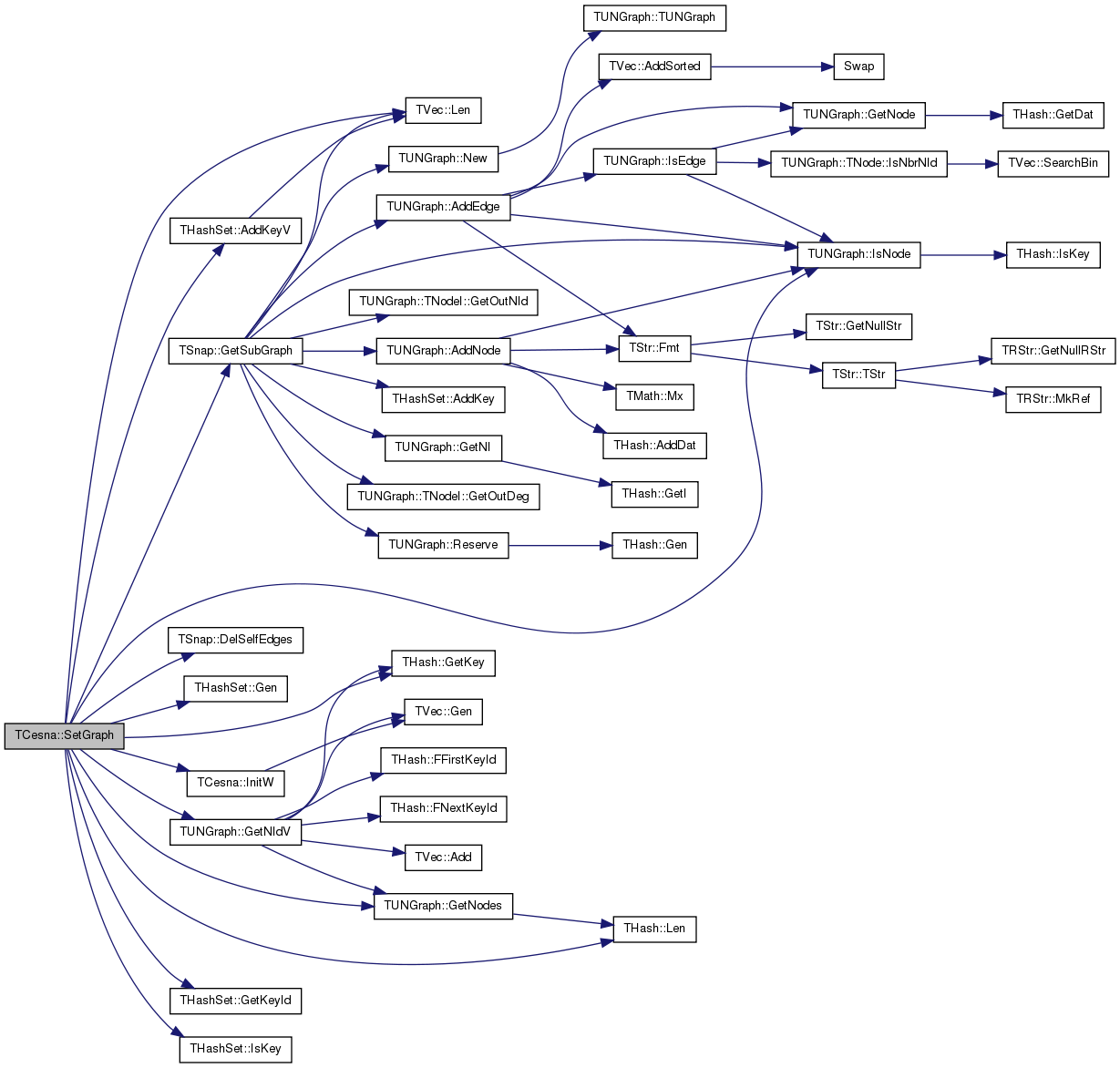

|
inline |
Definition at line 414 of file agmattr.h.
References GenHoldOutAttr(), and TCesnaUtil::GenHoldOutPairs().
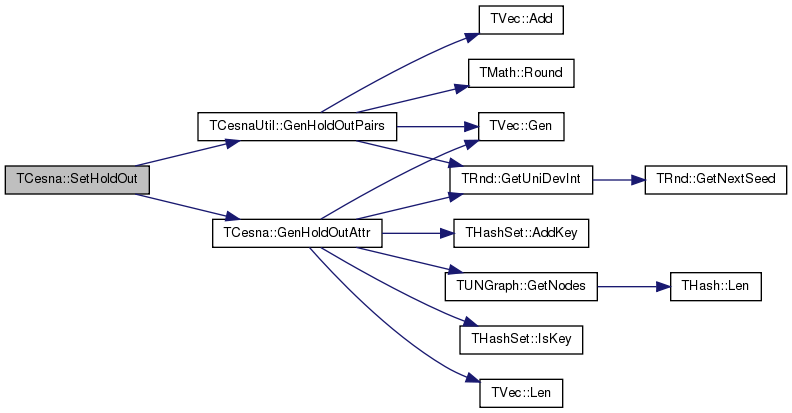
|
inline |
|
inline |
|
inline |
Definition at line 632 of file agmattr.h.
Referenced by PredictAttrK().

|
inline |
Definition at line 609 of file agmattr.h.
References THash< TKey, TDat, THashFunc >::BegI(), and THash< TKey, TDat, THashFunc >::EndI().
Referenced by LikelihoodForRow(), and LikelihoodGraph().


|
private |
Definition at line 252 of file agmattr.h.
Referenced by FindComs(), GenHoldOutAttr(), GetAttrs(), GetCmtyVV(), GetPositiveW(), GradientForRow(), InitW(), LikelihoodAttr(), LikelihoodForRow(), LikelihoodHoldOut(), MLEGradAscent(), MLEGradAscentParallel(), SetAttrHoldOutForOneNode(), and SetGraph().
| TBool TCesna::DoParallel |
Definition at line 269 of file agmattr.h.
Referenced by SetGraph().
Definition at line 250 of file agmattr.h.
Referenced by GetCmtyVV(), GradientForRow(), Likelihood(), LikelihoodForRow(), MLEGradAscent(), MLEGradAscentParallel(), NeighborComInit(), RandomInit(), and SetCmtyVV().
|
private |
Definition at line 248 of file agmattr.h.
Referenced by FindComs(), GetCmtyVV(), GetCmtyVVUnSorted(), GradientForRow(), LikelihoodForRow(), LikelihoodHoldOut(), MLEGradAscent(), MLEGradAscentParallel(), NeighborComInit(), RandomInit(), SetCmtyVV(), and SetGraph().
Definition at line 259 of file agmattr.h.
Referenced by FindComs(), GradientForRow(), LikelihoodForRow(), LikelihoodHoldOut(), and SetGraph().
Definition at line 258 of file agmattr.h.
Referenced by FindComs(), GradientForRow(), LikelihoodForRow(), LikelihoodHoldOut(), MLEGradAscentParallel(), and SetGraph().
| TFlt TCesna::LassoCoef |
Definition at line 266 of file agmattr.h.
Referenced by GetLassoCoef().
| TFlt TCesna::MaxVal |
Definition at line 262 of file agmattr.h.
Referenced by GetStepSizeByLineSearch().
| TFlt TCesna::MaxValW |
Definition at line 264 of file agmattr.h.
Referenced by GetStepSizeByLineSearchForWK(), MLEGradAscent(), and MLEGradAscentParallel().
| TFlt TCesna::MinVal |
Definition at line 261 of file agmattr.h.
Referenced by GetStepSizeByLineSearch().
| TFlt TCesna::MinValW |
Definition at line 263 of file agmattr.h.
Referenced by GetStepSizeByLineSearchForWK(), MLEGradAscent(), and MLEGradAscentParallel().
| TFlt TCesna::NegWgt |
Definition at line 265 of file agmattr.h.
Referenced by GradientForRow(), LikelihoodForRow(), LikelihoodHoldOut(), and SetGraph().
|
private |
Definition at line 254 of file agmattr.h.
Referenced by GetCmtyVV(), GetCmtyVVUnSorted(), SetCmtyVV(), and SetGraph().
|
private |
Definition at line 257 of file agmattr.h.
Referenced by GetCmtyVV(), GetCmtyVVUnSorted(), GetNumComs(), GetPositiveW(), GradientForWK(), MLEGradAscent(), MLEGradAscentParallel(), NeighborComInit(), RandomInit(), and SetCmtyVV().
| TFlt TCesna::PNoCom |
Definition at line 268 of file agmattr.h.
Referenced by SetGraph().
|
private |
Definition at line 255 of file agmattr.h.
Referenced by GetRegCoef(), GradientForRow(), and LikelihoodForRow().
|
private |
Definition at line 253 of file agmattr.h.
Referenced by FindComs(), MLEGradAscent(), MLEGradAscentParallel(), NeighborComInit(), and RandomInit().
|
private |
Definition at line 256 of file agmattr.h.
Referenced by GetCmtyVV(), GradientForRow(), LikelihoodForRow(), MLEGradAscentParallel(), NeighborComInit(), RandomInit(), and SetCmtyVV().
Definition at line 251 of file agmattr.h.
Referenced by GetW(), GradientForRow(), MLEGradAscent(), and MLEGradAscentParallel().
| TFlt TCesna::WeightAttr |
Definition at line 267 of file agmattr.h.
Referenced by FindComs(), GetWeightAttr(), GradientForRow(), LikelihoodForRow(), and LikelihoodHoldOut().
Definition at line 249 of file agmattr.h.
Referenced by SetGraph().